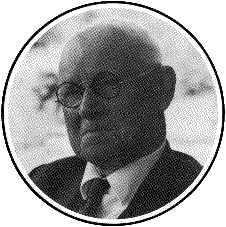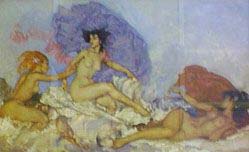
Studio Arts Gallery other Artists
Sorry we no longer deal with pictures by
Sir William Russell Flint
R.A., P.P.RW.S


Studio Arts Gallery other Artists
Sorry we no longer deal with pictures by
Sir William Russell Flint
R.A., P.P.RW.S

1880 -
1969
| Born
in Edinburgh on the 4th April 1880, the son of Francis Wighton Flint, a water colour artist and designer, Russell Flint certainly had the background for an artistic career. After Daniel Stewart's College, he entered the Royal Institution School of Art in Edinburgh where he learned the ground rules of line and colour which he was to develop into his own distinctive style. However, it was a six year apprenticeship as a draughtsman at a large printing works in Edinburgh which gave him the necessary discipline required of all great artists. In 1903 Russell Flint was taken on to the staff of the Illustrated London News as an artist illustrator. In that era before the photograph had entirely ousted drawing and engraving from the pages of newspapers and magazines, the artist was disciplined by the confines of time and editorial in a manner which has since vanished. The fact that the Illustrated London News was a journal distributed throughout the British Empire, took Flint's name around the world, laying a foundation for the international status he later enjoyed as a water colour artist. Philip Lee Warner, publisher, for whom Flint had already decorated an edition of Thomas à Kempis, was soon to form the Medici Society. He commissioned drawings for the publication of 'The Song of Soloman', which was eventually published in 1909. From then until the outbreak of World War I, Russell Flint illustrated a number of classical limited editions including Mallory's "Morte D'Arthur", Chaucer's "Canterbury Tales" and Homer's "Odyssey". The War took Flint into uniform, first in the R.N.V.R. as a lieutenant attached to the Royal Navy Air Service. By 1918 he had become "Admiralty Assistant Overseer - Airships" and returned to Scotland. He was in fact based at an Airship Station on the Clyde where he was able to commute to Glasgow and renew acquaintances at the School of Art. |
After
leaving the Service, Flint travelled to France and Spain and began to draw and paint the landscapes and small towns of the rural regions of those countries. By 1924 he was elected Associate of the Royal Academy and became a full member nine years later. During this period, and up until the outbreak of the Second World War, Flint's style became more free with an increasing emphasis on water colour which, under his brush, could represent the softness of a silk cushion or the rugged texture of a town building. In 1936 he became President of the Royal Society of Painters in Watercolour. During the war, Flint and his wife lived for a time on a turkey farm in Devon. Although he had no official standing as a war artist, his connection with Naval "top brass" allowed him access to Devonport Dockyard, where he painted as and when he liked. One of those subjects "H.M.S. Javelin - Devonport 1941" now hangs in the National Maritime Museum at Greenwich. By the end of the war, Flint was back in London living at Peel Cottage, Camden Hill. A short period of portraiture, mostly of friends like Richard Colman and W. Craig Henderson, led into what must be described as Flint's mature period. Those lovely watercolour paintings of arrogant peasant girls all stem from his post war period. His beautiful reclining models became a Russell Flint hallmark. This was that unique time in an artist's career when the subject matter and the medium fuse together under the artist's brush to form a style that is at once unique and captivating. William Russell Flint was knighted in 1947 and painted until his death at the age of 89. His career was long and distinguished - his painting has given immense pleasure to people across the world and through limited editions has reached an even wider public. |
Limited Edition Prints
|
|
 'Rocco Aphrodite' Size: 16" x 26" Copyright © Sir William Russell Flint Galleries Ltd SOLD |
|


BACK
50 North Road
Lancaster England LA1 1LT
Tel: +44 (0)1524 68014
Copyright © Studio Arts. All Rights
Reserved.